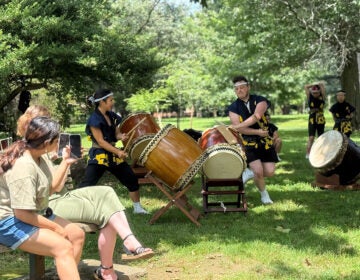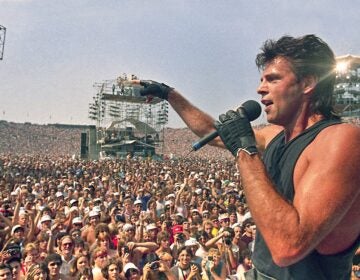Plans for American Revolution Center take shape
To the west is Independence Hall and Carpenter’s Hall, where the Continental Congress met for the first time. To the north is Ben Franklin’s print shop. To the south is where Thomas Paine printed “Common Sense,” which inspired revolution. Across the street is the First Bank of the United States.
In 1777, George Washington and his revolutionary troops marched right past what will be the front door of a museum dedicated to them.
“This is like a string of jewels that meet at this building,” said Michael Quinn.
In his temporary offices on Second Street, the president and CEO of the American Revolution Center gestured across architectural renderings of what the new museum will look like. The three-story building at Third and Chestnut streets will be in a modified Colonial style, meaning lots of brick and concrete window arches.
The architectural firm of Robert A.M. Stern designed a glass foyer, third-floor balcony, and shining cupola on top to bring the retro style up to date. Aiming for LEED certification, the 110,000-square-foot building will have green roofs. It will be much larger than anything that could have been built in the 18th century.
Colonial style and innovation
“We are also creating a building that will communicate to a traveler that this is a place to come,” said Quinn. “It’s a destination. You see that in the large-scale foyer entrance that radiates light and can serve as a beacon to pull people to this building site. It effectively, though subtly, meets those modern needs even though it still uses the vocabulary of historic buildings.”
The building is at least three years away from completion, and details are still being worked out. The interior will have a courtyard and skylight illuminating all three floors, an open-plan exhibition space where all that natural daylight cannot reach, and retail spaces open to the sidewalk.
The building plans are not yet finalized, and construction bids are a long way off. Quinn is releasing the architectural renderings now because the $150 million fundraising campaign is off and running.
Philadelphia philanthropist H.F. “Gerry” Lenfest has just promised a $40 million challenge grant, and the state of Pennsylvania has committed $30 million through the Redevelopment Assistance Capital Program.
Valley Forge collection will enrich museum
Those large commitments will likely attract both money and artifacts. The ARC, which was originally going to be built in Valley Forge, inherited a collection of historic objects which the Valley Forge Historical Society had been accruing for more than a century. As plans for the museum become firm, donations have spiked, said curator Scott Stephenson, including a recent bequest from the estate of Robert McNeil Jr., the inventor of Tylenol.
Stephenson is now cataloguing some 3,000 guns, swords, canteens, cups, letters and other objects. The pièce de résistance is the field tent from which Gen. George Washington commanded his troops. It will likely have its own dedicated room in the museum that will feature stories surrounding the tent, such as Washington’s personal servant — an African-American slave — whom the general kept with him while commanding troops from the field.
WHYY is your source for fact-based, in-depth journalism and information. As a nonprofit organization, we rely on financial support from readers like you. Please give today.




